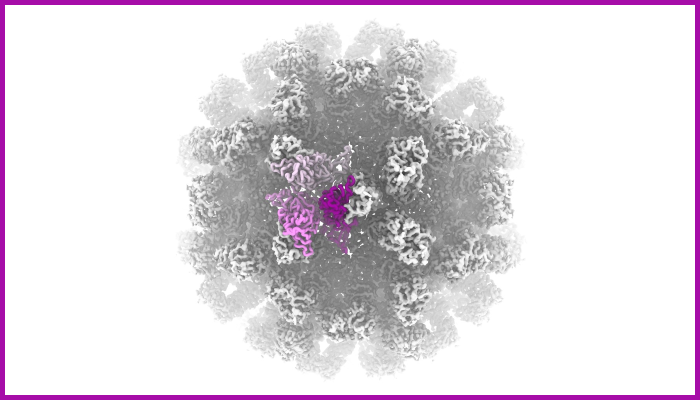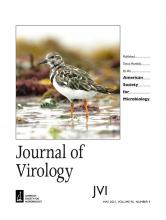Vesivirus 2117 structure highlights variations in entry pathways for viruses
Published: 19 April 2021
Centre for Virus Research scientists have solved the cryo-EM structure of the vesivirus 2117 capsid, highlighting potentially important differences related to virus attachment and entry.

Centre for Virus Research (CVR) scientists have solved the structure of the vesivirus 2117 capsid, the shell that encloses its genome, highlighting potentially important differences related to virus attachment and entry.
Vesivirus 2117 has caused significant losses in manufacturing of biopharmaceutical products following contamination of cell cultures used in their production.
Using new frontline cryo-electron microscope at the Scottish Centre for Macromolecular Imaging, researchers were able to solve the structure of the virus capsid at sufficient resolution to create an atomic model of the protein from which it is built.
Comparison of this structure with that of a related Vesivirus, feline calicivirus (FCV), highlighted potentially important differences related to virus attachment and entry.
The findings, published in ASM Journal of Virology, suggest that these two viruses may bind differently to receptors at the host cell surface, and also show that a region of the capsid protein of FCV that rearranges following receptor engagement is not present in vesivirus 2117.
These structural changes in the FCV capsid have been shown to allow assembly of a portal-like structure, hypothesised to deliver the viral genome to the cell's interior.
The data suggests that the 2117 portal assembly may employ a different means of anchoring to the outer face of the capsid.
Professor David Bhella, Professor of Structural Virology at the CVR, explained: "During the installation of our new frontline cryo-electron microscope at the Scottish Centre for Macromolecular Imaging, we were keen to test the new instrument’s automation processes.
"To do this, we used samples that we had previously studied at lower-resolution - virus-like particles produced by expression of the capsid protein of vesivirus 2117.
"My previous experiments with these particles suggested that they may not lead to a high-resolution structure, so I was happy to use these samples up while we ironed out any problems on the new microscope, the first of four produced by EM manufacturer JEOL and the first in the UK.
"To my surprise we were able to solve the structure of the virus capsid at sufficient resolution to build an atomic model of the protein from which it is built.
"Comparison to a closely related virus of cats - feline calicivirus, highlighted a potentially important structural difference in part of the virus that plays a key role in virus entry into the host cell.
"The data were processed as an honours project by a very bright undergraduate, Hazel Sutherland, who did a great job of calculating the reconstruction and built most of the atomic model.
"I am really happy that we were able to turn these data into a nice paper, and especially pleased that Hazel was able to achieve a first author publication from her project for all of her hard work."

The cryo-EM structure of vesivirus 2117 highlights functional variations in entry pathways for viruses in different clades of the Vesivirus genus.
- Hazel Sutherland, Michaela J. Conley, Edward Emmott, James Streetley, Ian G. Goodfellow, David Bhella
- Published online April 14, 2021. DOI: 10.1128/JVI.00282-21
First published: 19 April 2021

